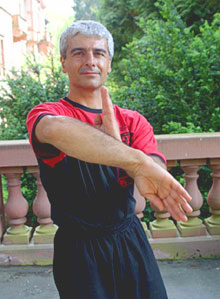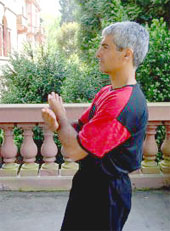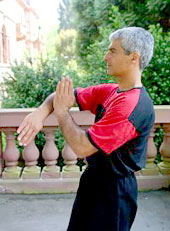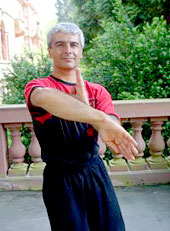|
|
Performing
the
Chum-Kiu
correctly
Dai-Si-Fu Giuseppe
Schembri provides hints on performing the first part of the
Chum-Kiu form correctly.
|
|
 |
The quality with which
the forms are practiced has a major influence on the ability to
apply the WT principles in actual combat.
The sequence of movements in the relatively short WingTsun forms
is quickly learned, but even masters constantly refine their
execution.
Naturally one could discuss countless aspects to which
particular attention must be paid when practicing the forms, but
the object of this series is not an exhaustive analysis of all
the movements in a form. Instead Dai-Sifu Schembri provides
examples of important aspects which should be noted.
Chum-Kiu
|
Part 1 – 1st
half:
After adopting the stance, the crossed Gan-Sao (Gau-Cha
Gan-Sao) is performed. The arms are then brought to the crossed
Tan-Sao position (Gau-Cha Tan-Sao) with an inner rotation (Kwan-Sao).
The arms are then returned to their initial position (Sao-Kuen).
After performing a punch on each side, as in the 1st form, both
hands are placed in front of the chest and thrust upwards as an
explosive movement (Chuen-Kiu).
There is then a turn to the left while bending the arms, the
left above the right. This is followed by a turn to the right,
then back to the left.
Both arms are then stretched forward with the palms downward.
The left forearm forming a Tan-Sao is struck with the right palm,
then the right forearm with the left palm. This sequence is
repeated twice more.
The right palm is thrust forward (Ching-Cheung) while the left
hand adopts the Wu-Sao position. After performing this three
times, there is a turn to the right while bending the arm to
form Lan-Sao. A crossed Tan-Sao is then performed in front the
chest, followed by a forward turn with Bong-Sao. This sequence
is repeated twice more.
After the last Lan-Sao movement, a punch is executed over the
right forearm with the right arm. The first section is concluded
with a turn to the starting position and a Fak-Sao to the left.
The whole sequence is repeated on the other side. |


 |
NOTE:
When performing the Bong-Wu movement, make sure that the Wu is
not withdrawn. It is erected where it is, and remains there. The
Bong-Sao is in front of the body. The arms are not moved during
the turn.
A detailed description of the Chum-Kiu form with
numerous photos may be found in “Chum-Kiu of the WingTsun System“
by Grandmaster Leung Ting.
Source:
WINGTSUN World
|